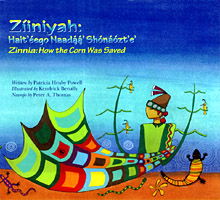Patricia’s new picture book – bilingual in Navajo and English
A Curriculum Guide to be used with Zinnia: How the Corn Was Saved (Word document)
ZINNIA is my second book, also with a wonderful publisher, Salina Bookshelf of Flagstaff, AZ. And I love Kendrick Benally’s illustrations. I am the first non-Navajo author that Salina Bookshelf has published, and I feel honored that they chose my story.
The process of ZINNIA’s publication has been a very different experience than that of BLOSSOM TALES with Moon Mountain, from my standpoint. The BLOSSOM TALES illustrations were sent to me on-line by the publisher (Moon Mountain) as Sarah Dillard (the illustrator) completed them, and then refined them, over the course of a year. For ZINNIA, I didn’t have an inkling of the illustrations until Salina sent me the completed color proof in the form of a scroll (rather than a folded book). I was floored. The illustrations are brilliant and gorgeous. And the book came out less than two months later.
In fact, Erik Lockard, the Salina Bookshelf publisher, accompanied Kendrick’s artwork to Hong Kong where the book was printed (most picture books are printed in eastern Asia), in order to be assured that the colors came out true. I have subsequently learned that turquoise is a difficult color to reproduce. ZINNIA is loaded with turquoise, but also magenta, purple, greens, oranges and yellow.
I’m going outside now to plant some corn amongst my yellow zinnias.
Reviews of Zinnia
“In this graceful retelling of a well-known Navajo folktale, a boy is sent to find Spider Woman to ask her how to save his people’s crops. Along the way, Red Bird unwittingly disturbs a spider on her web. He meets several different desert animals and asks each one for directions. After climbing in and out of a canyon and circling back to where he started, he finds Spider Woman, who is angry that he did not notice her before. He appeases her with pleasant words, and she advises him that his people should plant zinnias along with their vegetables. The quiet tone and spare plot are true to the style of many Native American tales, and this version is not cluttered with modern additions. Written in both Navajo and English, the text is gorgeously illustrated. The stylized artwork features rich colors and bold shapes with soft outlines. Both the palette and the lines evoke the Southwest. Using varying and unusual points of view, Benally effectively shows the many shapes of the terrain. The author detail her sources as well, describing how the Navajo hold their stories sacred. A stunning work.”
– Cris Riedel
Ellis B. Hyde Elementary School, Dansville, NY
School Library Journal, June 2004
